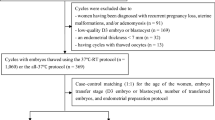Abstract
Purpose
The aim of this prospective randomized control trial was to evaluate if the use of two different volumes (20–25 vs 40–45 μl) of media used for embryo transfer affects the clinical outcomes in fresh in vitro fertilization (IVF) cycles.
Methods
In total, 236 patients were randomized in two groups, i.e., “low volume” group (n = 118) transferring the embryos with 20–25 μl of medium and “high volume” group (n = 118) transferring the embryos with 40–45 μl of medium. The clinical pregnancy, implantation, and ongoing pregnancy rates were compared between the two groups.
Results
No statistically significant differences were observed in clinical pregnancy (46.8 vs 54.3%, p = 0.27), implantation (23.7 vs 27.8%, p = 0.30), and ongoing pregnancy (33.3 vs 40.0%, p = 0.31) rates between low and high volume group, respectively.
Conclusion
Higher volume of culture medium to load the embryo into the catheter during embryo transfer does not influence the clinical outcome in fresh IVF cycles.
Trial registration number: NCT03350646


Similar content being viewed by others
References
Schoolcraft WB, Surrey ES, Gardner DK. Embryo transfer: techniques and variables affecting success. Fertil Steril. 2001;76:863–70.
Bontekoe S, Heineman MJ, Johnson N, Blake D. Adherence compounds in embryo transfer media for assisted reproductive technologies. Cochrane Database Syst Rev. 2014;2:CD007421.
Abou-Setta AM, Al-Inany HG, Mansour RT, Serour GI, Aboulghar MA. Soft versus firm embryo transfer catheters for assisted reproduction: a systematic review and meta-analysis. Hum Reprod. 2005;20:3114–21.
Mansour RT, Aboulghar MA. Optimizing the embryo transfer technique. Hum Reprod. 2002;17:1149–53.
Sigalos G, Triantafyllidou O, Vlahos N. How do laboratory embryo transfer techniques affect IVF outcomes? A review of current literature. Hum Fertil (Camb). 2017;20:3–13.
Poindexter AN 3rd, Thompson DJ, Gibbons WE, Findley WE, Dodson MG, Young RL. Residual embryos in failed embryo transfer. Fertil Steril. 1986;46:262–7.
Leeton J, Trounson A, Jessup D, Wood C. The technique for human embryo transfer. Fertil Steril. 1982;38:156–61.
Ebner T, Yaman C, Moser M, Sommergruber M, Polz W, Tews G. The ineffective loading process of the embryo transfer catheter alters implantation and pregnancy rates. Fertil Steril. 2001;76:630–2.
Montag M, Kupka M, van der Ven K, van der Ven H. Embryo transfer on day 3 using low versus high fluid volume. Eur J Obstet Gynecol Reprod Biol. 2002;102:57–60.
Lee HC, Seifer DB, Shelden RM. Impact of retained embryos on the outcome of assisted reproductive technologies. Fertil Steril. 2004;82:334–7.
Halvaei I, Khalili MA, Razi MH, Agha-Rahimi A, Nottola SA. Impact of different embryo loading techniques on pregnancy rates in in vitro fertlization/embryo transfer cycles. J Hum Reprod Sci. 2013;6:65–9.
Christianson MS, Zhao Y, Shoham G, Granot I, Safran A, Khafagy A, et al. Embryo catheter loading and embryo culture techniques: results of a worldwide web-based survey. J Assist Reprod Genet. 2014;31:1029–36.
World Health Organization. WHO Laboratory Manual for the Examination and Processing of Human Semen, 2010 5th edn Geneva World Health Organization.
Alpha Scientists in Reproductive M, Embryology ESIGo. The Istanbul consensus workshop on embryo assessment: proceedings of an expert meeting. Hum Reprod. 2011;26:1270–83.
De los Santos MJ, Apter S, Coticchio G, Debrock S, Lundin K, Plancha CE, et al. Revised guidelines for good practice in IVF laboratories (2015). Hum Reprod. 2016;31:685–6.
Friedman BE, Lathi RB, Henne MB, Fisher SL, Milki AA. The effect of air bubble position after blastocyst transfer on pregnancy rates in IVF cycles. Fertil Steril. 2011;95:944–7.
Schulman JD. Delayed expulsion of transfer fluid after IVF/ET. Lancet. 1986;1(8471):44.
Gambadauro P, Navaratnarajah R. Reporting of embryo transfer methods in IVF research: a cross-sectional study. Reprod BioMed Online. 2015;30:137–43.
Hearns-Stokes RM, Miller BT, Scott L, Creuss D, Chakraborty PK, Segars JH. Pregnancy rates after embryo transfer depend on the provider at embryo transfer. Fertil Steril. 2000;74:80–6.
Brown J, Buckingham K, Buckett W, Abou-Setta AM. Ultrasound versus ‘clinical touch’ for catheter guidance during embryo transfer in women. Cochrane Database Syst Rev. 2016;3:CD006107.
Kava-Braverman A, Martinez F, Rodriguez I, Alvarez M, Barri PN, Coroleu B. What is a difficult transfer? Analysis of 7,714 embryo transfers: the impact of maneuvers during embryo transfers on pregnancy rate and a proposal of objective assessment. Fertil Steril. 2017;107:657–63 e1.
Krampl E, Zegermacher G, Eichler C, Obruca A, Strohmer H, Feichtinger W. Air in the uterine cavity after embryo transfer. Fertil Steril. 1995;63:366–70.
Abou-Setta AM. Air fluid versus fluid-only models of embryo catheter loading: a systematic review and meta-analysis. Reprod BioMed Online. 2007;14:80–4.
Grygoruk C, Pietrewicz P, Modlinski JA, Gajda B, Greda P, Grad I, et al. Influence of embryo transfer on embryo preimplantation development. Fertil Steril. 2012;97:1417–21.
Schoolcraft WB. Importance of embryo transfer technique in maximizing assisted reproductive outcomes. Fertil Steril. 2016;105:855–60.
Bodri D, Colodron M, Garcia D, Obradors A, Vernaeve V, Coll O. Transvaginal versus transabdominal ultrasound guidance for embryo transfer in donor oocyte recipients: a randomized clinical trial. Fertil Steril. 2011;95:2263–8. 8 e1
Author information
Authors and Affiliations
Corresponding author
Ethics declarations
The study was approved by the Aretaieion University Hospital ethics committee (School of Medicine, National and Kapodistrian University of Athens, registration no. B-74/30-10-2014). Informed consent form was obtained from all patients.
Conflicts of interest
The authors declare that they have no conflicts of interest.
Rights and permissions
About this article
Cite this article
Sigalos, G.Α., Michalopoulos, Y., Kastoras, A.G. et al. Low versus high volume of culture medium during embryo transfer: a randomized clinical trial. J Assist Reprod Genet 35, 693–699 (2018). https://doi.org/10.1007/s10815-017-1099-8
Received:
Accepted:
Published:
Issue Date:
DOI: https://doi.org/10.1007/s10815-017-1099-8




